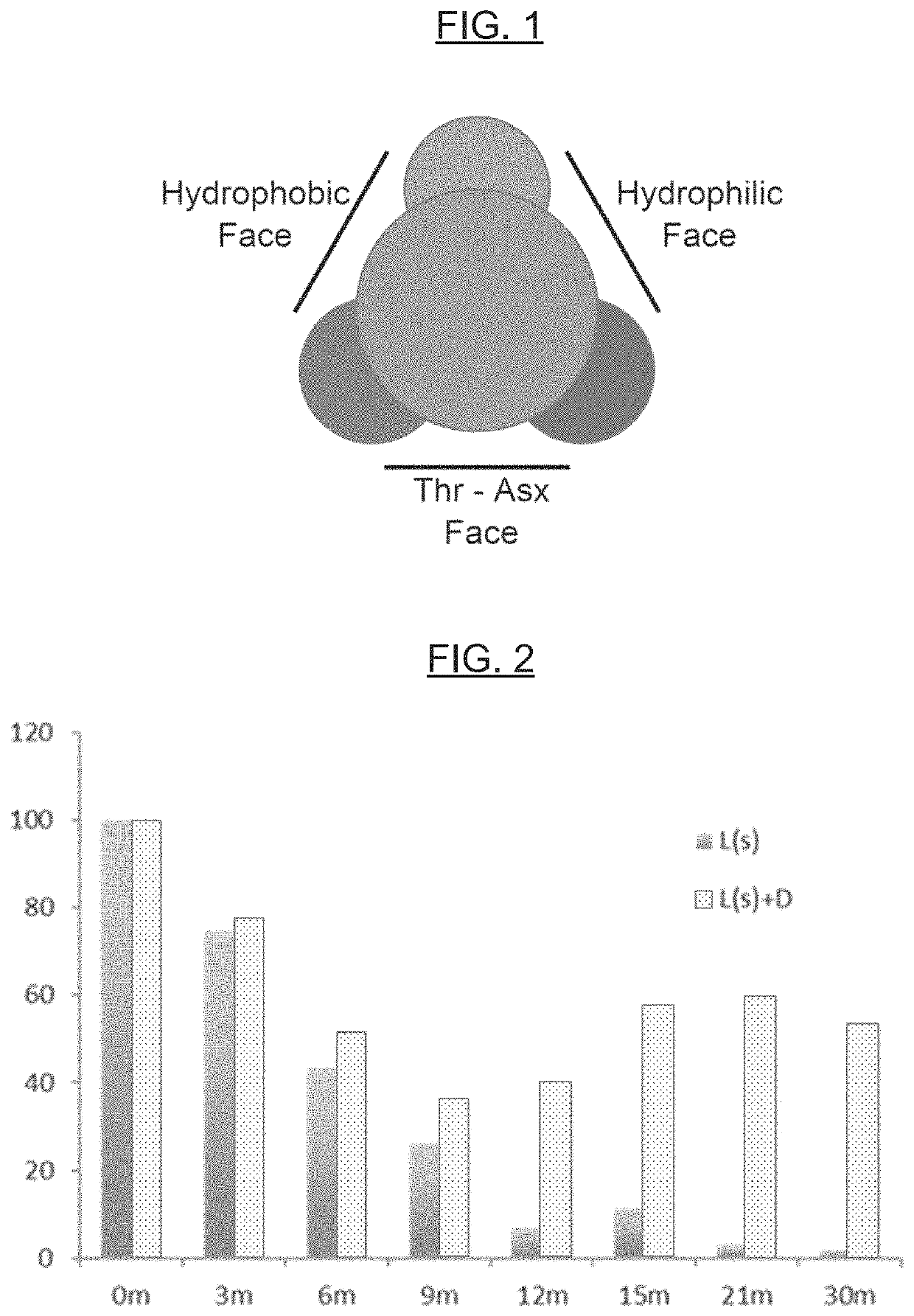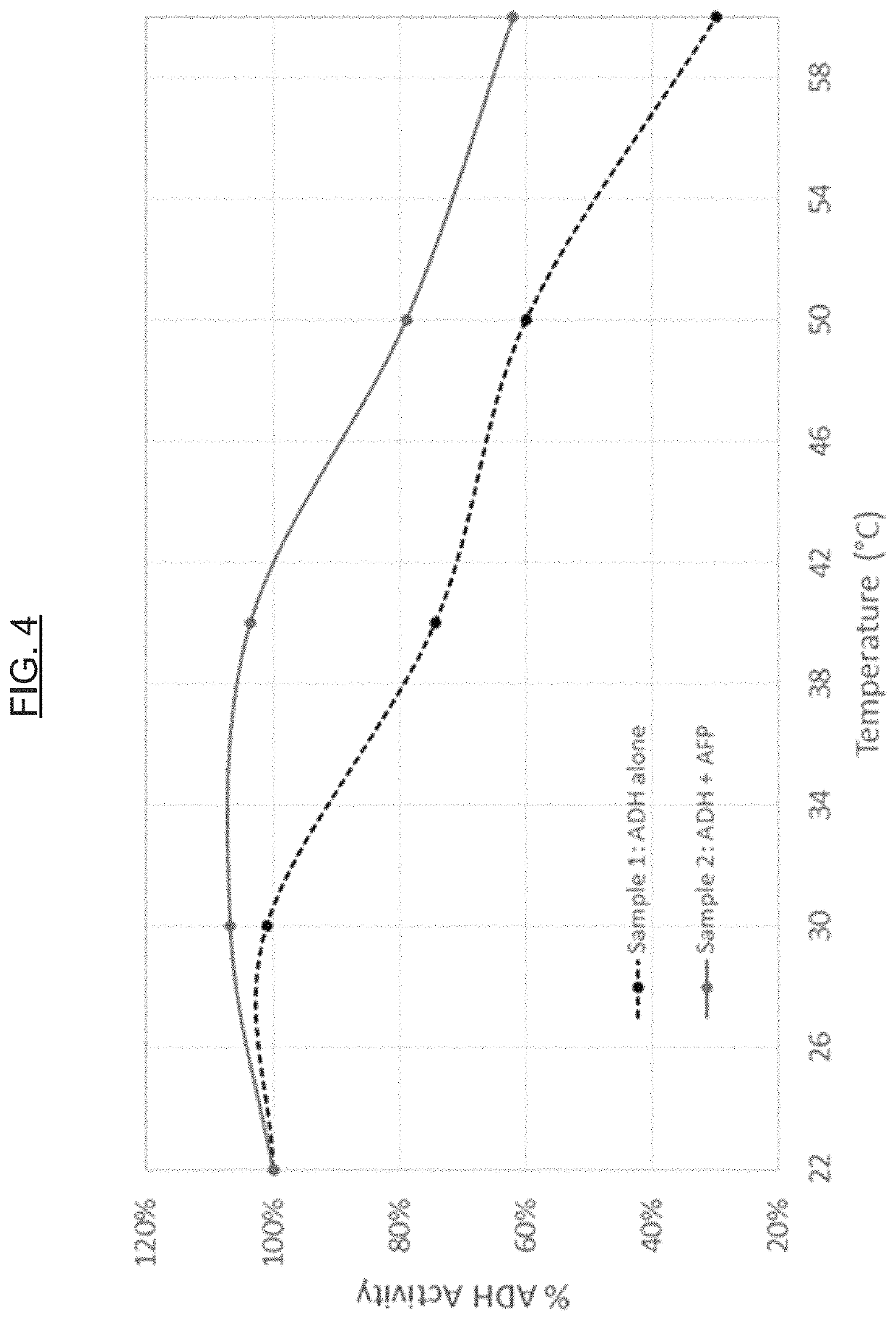Composition and method for the protection of proteins, cell components and cells during temperature stress
a technology of cell components and proteins, applied in the field of protein stabilization, can solve the problems of increasing the cost of proteins, shortening the shelf life, and unstable proteins, and achieve the effect of storage stability of protein formulations
- Summary
- Abstract
- Description
- Claims
- Application Information
AI Technical Summary
Benefits of technology
Problems solved by technology
Method used
Image
Examples
example 1
n for Proteins Under Temperature Stress by AFPs
[0077]Proteins, including enzymes, are utilized in a variety of applications (e.g., diagnostic, therapeutic, foods, and animal feeds / nutrition). For example, the potential commercial applications of enzymes for maximizing animal performance through the improvement of nutrient digestion is significant. In another example, the enzyme glucose oxidase is used in diagnostic applications, such as (or including) glucose assays. The hormone insulin is an example of a protein utilized in therapeutic applications. Unfortunately, the main obstacle for the full development of these markets is the observation that many proteins are intrinsically unstable (see, e.g., WO 2003 / 040398 A2 and U.S. Pat. No. 8,399,230 B2). AFPs show a highly effective thermoprotective effect on the activity of enzymes in model systems, namely lactate dehydrogenase (LDH) and alcohol dehydrogenase (ADH), and can be used to protect other proteins in general against thermal de...
example 2
n for Proteins Under Freeze / Thaw Stress by AFPs
[0081]During the freezing process of a solution containing water, ice will usually form. The presence of ice will destabilize various biologics, such as therapeutic proteins, enzymes, cells, tissues, and organs (Ratanji et al., “Immunogenicity of therapeutic proteins: Influence of aggregation,”J Immunotoxicol., 2014 April; 11(2): 99-109.).
[0082]As previously mentioned, AF(G)Ps are characterized by their ability to specifically bind to ice. AF(G)Ps may protect biologics under freeze / thaw stress by avoiding the direct exposure of delicate biologics to ice. We have successfully demonstrated that AFPs can protect biologics under freeze / thaw stress.
[0083]AFPs show a cryoprotective effect on the activity of enzymes in model systems (e.g., lactate dehydrogenase [LDH]), and can be used to protect enzymes in general against freezing and thawing deactivation. The protective effects of AFPs are greater than those of commonly used protectants or st...
example 3
n for Microbes Under Freeze / Thaw Stress by AFPs
[0086]This example shows that TmAFP protects microbes. Bacterial cells (e.g., DH5α, BL21) were used as model cell systems from freezing and thawing. For example, DH5α competent cells are often used for general cloning and subcloning, and BL21 strains are descended from the E. coli B strain and have been specifically constructed for high-level expression of recombinant proteins with two important attributes that make them ideal for protein expression (e.g., key genetic markers and inducibility of protein expression). The cell viability of these cells was assayed by counting the number of isolated bacterial colonies per area of LB agar plate.
[0087]The bacteria cells were grown in LB media with appropriate amounts of antibiotics. For example, ampicillin (100 μg / ml) and kanamycin (30 μg / ml) were added to LB media inoculated with E. coli (DH 5α pET 28a), which were grown overnight at 37° C. 800 μL of the cell culture were transferred into ea...
PUM
| Property | Measurement | Unit |
|---|---|---|
| molecular weights | aaaaa | aaaaa |
| molecular weights | aaaaa | aaaaa |
| pH | aaaaa | aaaaa |
Abstract
Description
Claims
Application Information
 Login to View More
Login to View More - R&D
- Intellectual Property
- Life Sciences
- Materials
- Tech Scout
- Unparalleled Data Quality
- Higher Quality Content
- 60% Fewer Hallucinations
Browse by: Latest US Patents, China's latest patents, Technical Efficacy Thesaurus, Application Domain, Technology Topic, Popular Technical Reports.
© 2025 PatSnap. All rights reserved.Legal|Privacy policy|Modern Slavery Act Transparency Statement|Sitemap|About US| Contact US: help@patsnap.com



